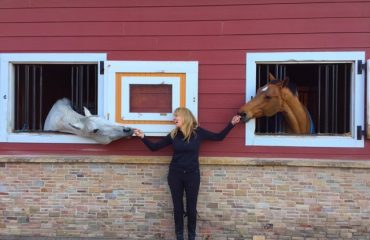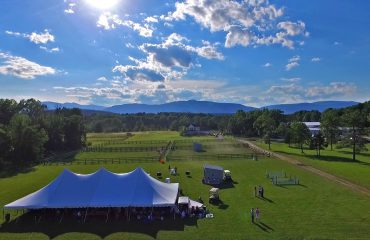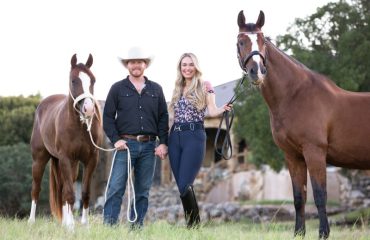In 1992, Dot Morgan founded the New Vocations Racehorse Adoption Program to re-train and find new “jobs” for Standardbreds and Thoroughbreds after their careers in harness and on the flat came to a halt. The program, a 501(c)3 public charity; which is dependent on donations to fulfill its mission, was born out of the need to help ex-racehorses – some were injured, some too thin and most of them lacked the skills necessary to swap careers. They needed a safe haven, rehabilitation and continued education.
Since its inception, New Vocations has placed more than 3,700 horses, with 423 adopted in 2011. The program has expanded from its original venue near Dayton to another facility in Marysville, also in Ohio, plus locations in Lexington (KY), Manchester (MI), Hummelstown (PA) and Monterey (TN). The horses themselves come from about 40 tracks throughout the country and thanks to the dedicated staff, are placed into experienced, caring homes in 32 states. “In the past 20 years I have seen people become a lot more concerned with the welfare of horses. Most people don’t realize what can happen to racehorses after their careers end – my husband and I are trainers and we weren’t aware of it,” says Dot. “I believed that there were qualified families out there who could take a horse but couldn’t justify paying $3,000 to $4,000 for it. They needed a liaison.”

Frazee's Folly raced an amazing 90 times winning over 1/2 million dollars. Folly retired sound and was adopted through New Vocations by Megan Roland who shows him successfully in dressage.
Enter Dot and New Vocations
New Vocations Racehorse Adoption Program “believes in the talent and potential of the horses. It endeavors to stand in the gap providing a transitional haven and skilled hands, loving care and tough love, a future of hope and a brighter tomorrow.” Dot wears many hats and she’s singularly suited to lead this unusual mission. Her husband of 40 years is fifth generation trainer-driver Charles Morgan. They remain active in Standardbred racing and Dot managed their breeding and boarding farm, spending 14 years as a director of the Ohio Harness Horsemen’s Association and 10 years as a 4-H Advisor. “In the beginning it was a lot easier to place the horses, because feed was cheaper and there were less unwanted horses,” explains Dot. ,“Now, however, with the high cost of feed and a glut of unwanted horses, we have to put a lot more resources into making the Standardbreds and Thoroughbreds more appealing. We evaluate them for health and soundness, put hours into schooling them and screening adopters and monitoring the homes. Our adoption fees have dropped steadily over the years and range from about $700 max to an average of $200 per horse. Fees are refundable within 60 days if the horse does not work out or proves unsuitable.”

Mi Forest Amor: this 6-year-old Thoroughbred, 16 1/2hh, chestnut gelding is waiting for someone to fall in love with him. Adoption fee: $500 Bet he's gone when you visit the New Vocations website - bet you fall in love with another very adoptable ex-racehorse: horseadoption.com
New Vocation’s philosophy is very different from organizations such as the Thoroughbred Retirement Foundation or Standardbred Retirement Foundation, which boards ex-racehorses on farms where they live out their days. Last year stories in the news talked about how TRF took in so many horses that they filled participating farms to capacity. They were overwhelmed and there simply wasn’t room to retire any more ex-racehorses. At New Vocations, however, Dot, her daughter Anna Ford and their volunteers are committed to putting horses into homes where each one receives attention and has a purpose.
Fresh Starts for Ex-Race Horses
“We feel that we’re serving the industry in the best way possible,” explains Dot. “We have a full time person who monitors the adoptions and approves the applications. We follow up on all horses who are adopted for one year, investing a lot of time, energy and cost; but we want to make sure that these horses are safe and sane for their new owners and also that the people are seeing to the horses’ health and well-being. Bad things can happen to good people: they might run into job or financial trouble or the home might break up in divorce. It’s stated clearly in the adoption contract that we will always take the horse back. We have as many as 100 graduates of our New Vocations program returned each year; but we have going on 4,000 horses out there.” Dot is very humble about the scope of New Vocations. It is the biggest racehorse adoption program in the country. Because the founder herself comes from a family of horsemen that have raised Standardbreds for more than 100 years, the program is rooted in time-tested horse-keeping and training practices. “All the people who come to work for us are horse people who have experience at the racetrack and/or the show ring, most of them are college graduates and many have degrees in animal science,” stated Dot, who earned her B.S. in Agriculture from the University of Kentucky. “We can identify injuries in the horses, we have excellent access to veterinarians and once we sort out a horse’s soundness issues, we can deal with their schooling. When a horse is ready for adoption, we can offer a high level of confidence that a horse is suited for this or that discipline. We put our resources into equipping the horses with skills: we get on them, get them to go through water, get them going well in the ring and out of the ring, and when possible we take them on the trail.”

Call Me Gold (Thoroughbred) ran 37 times and upon retirement came to New Vocations. Anna Harbaugh adopted Gold several years ago and the duo compete successfully in hunters. Shown here on course at the New Vocations Charity Show during the Thoroughbred Hunter Classic
New Vocations receives applications from a few pleasure drivers; but most adopters want to ride their horses. Dot and her people spend time preparing them for under saddle work and videotaping them being ridden. Thoroughbreds out number Standardbreds, about 60% to 40% in the New Vocations’ program, but many of the Standardbreds end up becoming successful field hunters, dressage and event horses. What happens after a horse is adopted depends on the new owner. The ideal adopter either has the skills or will seek out good trainers so that horse and rider achieve partnership and success in their sport or discipline.
Apples Don’t Fall Far From The Tree
Anna (Morgan) Ford, directs the Thoroughbred side of New Vocations. Born into a family of horsemen and racehorse trainers, she learned to ride when most toddlers take their first wobbly steps. At the tender age of 10, Anna was riding a leased gaited horse with a reputation as a “bad actor”: she was such a strong rider that the duo won the Walk-Trot World Championship in Louisville (KY).
“My daughter is incredible,” says Dot. “She was 13 when I started New Vocations and she rode the Thoroughbreds for me. She went to Ohio State University, traveled overseas and spent six months in South Africa. When she came back in 2001, she told me, “this isn’t my mission, this is your mission; but I’ll help you for a year.” It wasn’t long before it became Anna’s vision, too, and hers was far bigger than mine. Anna really is the heart and soul of New Vocations – her passion, her youth, her inspiration – and it is Anna who said, “we’ll open more locations and help more horses.”
In typical mother-daughter dynamics, they have differing versions of how Anna became involved full-time. Anna got married and the couple lived on the family farm for a few months. She couldn’t miss seeing how much the New Vocations program had grown.
“It was growing into something much greater than my mom could handle on her own and initially I just wanted to help lighten the load in some way,” recalls Anna. “But it just sort of all fell together. I really enjoyed it, especially working with the Thoroughbreds. I had grown up with horses on a breeding and training farm. I took a break from it during college – we took only one vacation because of the horses – and when I got back into it, I never turned away again. I’ve always enjoyed the Thoroughbreds. Their appearance and their athleticism especially appeal to me.”
Anna is now based in Columbus and works out of the Marysville office. When she started out, they took in about 10 horses at a time; but the program has grown considerably from one location to six. On any given day, the New Vocations program will show 60-65 horses on their books. Because of the staff’s expertise with ex-racers, horses are usually adopted before two months pass and many “disappear” off the website within a few days of being posted. Adoptions are helped by the reliable reputation associated with New Vocations.
“The need is so great,” emphasizes Anna. “There are so many horses out there on the track. I have done everything from schooling horses to promoting New Vocations. My focus now involves development and fundraising.” Money – that’s the bottom line. Horses eat, well, like horses. Realistically, from training to adoption takes about two months. Meeting NV’s qualifications to adopt goes beyond money to support the horse: you need experience and expertise.
Standardbreds are typically more tolerant. Bred to race in harness as trotters and pacers, most can be easily gaited and offer a smooth ride. However, they usually require a skilled rider with strong aids to train them to canter. Standardbreds excel as trail horses. They also make good foxhunters and reenactment mounts. With the right rider, they can do well in dressage and eventing. Thoroughbreds arrive at New Vocations a bit more sensitive, sometimes very reactive; but they’ve been pampered like exotic flowers. They are extremely athletic, tend to be very smart and learn quickly with an experienced and tactful rider. On the hunt for a new Dobbin? Check out New Vocations Racehorse Adoption Program: www.horseadoption.com
All Photos Courtesy of New Vocations Racehorse Adoption Program
-By Lauren Giannini













